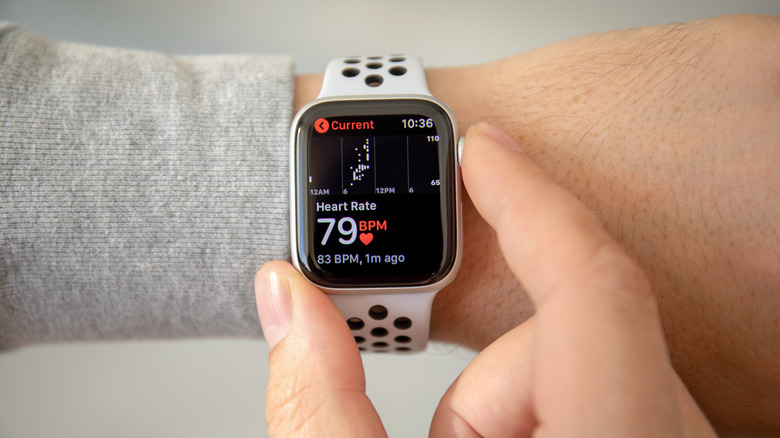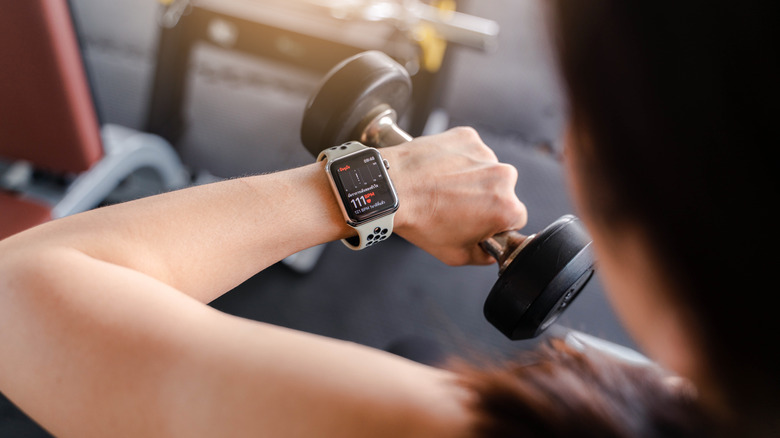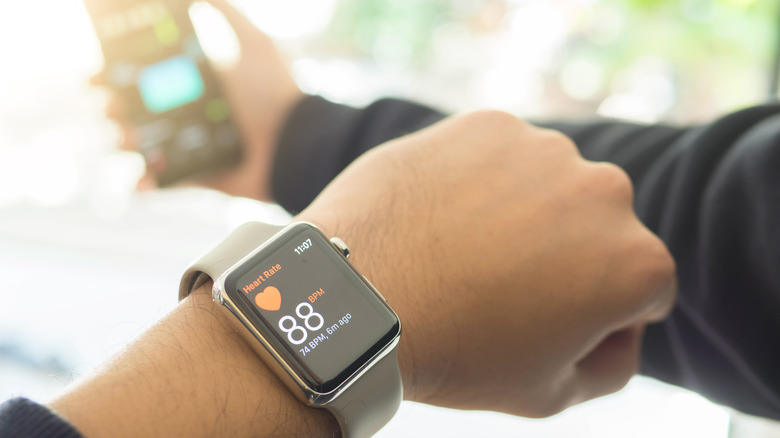How To Track Your Heart Rate On Your Apple Watch
When it comes to heart health, most doctors will tell you the more information, the better. The good news is that the Apple Watch you have strapped to your wrist has several tools to help you keep track of key data about your cardiovascular health, including just how fast your heart is beating. While this may seem like a simple metric, the number you see on the screen can tell you a lot about your heart health.
Using the Apple Watch to keep an eye on your heart rate can let you know if your resting heart rate is too high — information that could save your life. However, it's not just about lifesaving information; keeping track of your heart rate on your Apple Watch can help you get into and stay in shape. Knowing your heart rate can help you monitor the intensity of a workout and even give you insight into whether it's time to drink more water or cut back on caffeine. To get all of those benefits, you'll need to know how to track your heart rate on your Apple Watch. Here, we show you how.
How to track your heart rate using the Heart Rate app
While the heat rate information you get from your Apple Watch is less precise than what you'd get in a medical setting, a study in the Digital Health journal found its readings to be pretty accurate. The device uses an optical heart sensor with photoplethysmography technology to measure your heart rate by detecting the blood flow through your wrist. During a workout, the watch continuously measures your heart rate for real-time feedback, and once you've finished, you can view your average rate for the entire workout.
The Apple Watch also measures your heart rate from time to time throughout the day and keeps track of your resting heart rate. As you can probably imagine, all of this tracking can take its toll on the watch's battery, with some saying this setting can ruin the Apple Watch experience. However, if this information is important to you, you're probably okay with charging your watch a little more frequently to ensure this valuable data is always available to you.
Follow these steps to track your heart rate with the Apple Watch:
- Press the Digital Crown on your Apple Watch to access the app screen.
- Tap the heart-shaped Heart Rate app icon.
- Wait for the app to display your current heart rate.
- Swipe up to view your resting rate.
Track your heart rate directly on your Apple Watch face
If you want to monitor your heart rate information from your Apple Watch face throughout the day without opening the Heart Rate app, you can do that by setting up a complication. Before setting up a complication, you'll need to confirm that the watch face you're using supports it. If it does, you're good to go; if not, all you have to do is change to a watch face that is compatible with this function. Once you've done that, you'll be able to view your heart rate data quickly.
Follow these steps to add a heart rate complication:
- Press the digital crown to go to your watch face.
- Tap and hold the watch face to enter edit mode. Then, select Edit.
- Swipe left until you get to the end.
- If your watch face supports complications, you can view them on the last screen.
- Tap an existing complication, scroll through the list, and select the Heart Rate complication.
- Press the Digital Crown to save your changes and exit edit mode.
Your watch face will now display the Heart Rate complication, making it easier to keep track of your heart rate throughout the day. Tracking your heart rate with the Apple Watch can help you understand your heart rate trends over time. If your heart rate is consistently high, that could indicate stress or fatigue. In contrast, a low heart rate typically reflects good cardiovascular fitness. You can use this information to make informed decisions about your health and fitness routine.


